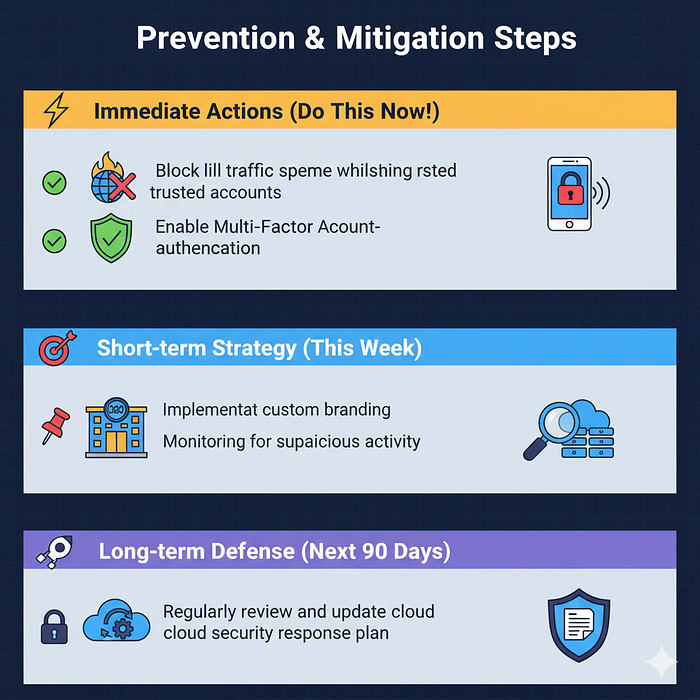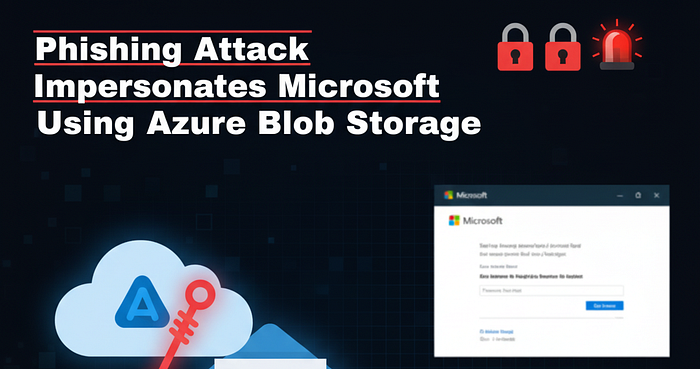In recent months, a new phishing attack has emerged that leverages Microsoft Azure Blob Storage to craft highly convincing phishing sites that mimic legitimate Office 365 login portals. This attack puts Microsoft 365 users at severe risk of credential theft, highlighting the dual-edged nature of cloud services.
📋 Executive Summary
A surge in phishing campaigns using Azure Blob Storage to impersonate Microsoft has been observed. The attacks use deceptive emails with links disguised as routine Microsoft Forms surveys or document shares. Once victims click on these links, they are redirected to a fake login page where they are prompted to enter their Microsoft 365 credentials.
🔍 What Happened
The phishing scheme typically begins with an email that includes a link with a URL like forms.office[.]com followed by a unique identifier. When the victim clicks on this link, they are redirected to a PDF download prompt. However, upon clicking "Download," the user is suddenly asked to log in to their Microsoft 365 account.
The malicious URL terminates in windows.net, specifically utilizing subdomains under blob.core.windows.net, which hosts the phishing form as a simple HTML file stored in Azure's blob storage service. This storage solution, designed for unstructured data like images or documents, inadvertently provides phishers with a veil of legitimacy since browsers and endpoint protection tools inherently trust Azure endpoints.
⚙️ Attack Methodology — Technical Deep Dive
🚪 Initial Access
The attack begins when an attacker compromises the victim's email account using social engineering tactics. They send a phishing email with a link that appears to be from Microsoft Forms, which is a legitimate service used for surveys and document sharing.
🔧 Execution & Techniques
Once the victim clicks on the link, they are redirected to a fake login page hosted on Azure Blob Storage. The attackers use a technique called "URL hijacking" to redirect the user's browser to the phishing site. This involves manipulating the URL of the original email to point to the malicious site.
🎭 Exploitation Details
The attack exploits a vulnerability in the way Azure Blob Storage handles requests from clients. Since Azure endpoints are trusted by default, browsers and endpoint protection tools do not flag these requests as suspicious. However, this also means that attackers can host phishing sites on Azure without being detected.
📊 Attack Flow Diagram (Text)

In this attack flow, the attacker first compromises the victim's email account. They then send a phishing email with a link that redirects the user to a fake login page hosted on Azure Blob Storage. Once the user enters their credentials, they are captured and sent to an attacker-controlled server.
💡 Key Learning Points
🎓 For Security Teams:
1. [Lesson 1] — Be aware of phishing attacks using Azure Blob Storage. These attacks can be sophisticated and difficult to detect.
2. [Lesson 2] — Regularly review your organization's cloud security posture to ensure that all services are properly configured and up-to-date.
3. [Lesson 3] — Implement additional security measures such as multi-factor authentication and monitoring for anomalous logins.
👥 For General Users:
1. [Lesson 1] — Be cautious when clicking on links from unknown senders, even if they appear to be from Microsoft.
2. [Lesson 2] — Verify the URL of any link before entering your credentials.
🛡️ Prevention & Mitigation Steps

⚡ Immediate Actions (Do This Now!)
- ✅ Block all traffic to *.blob.core.windows.net endpoints in firewalls or web proxies.
- ✅ Whitelist only specific, trusted storage accounts like <your-storage-account>.blob.core.windows.net.
- ✅ Enable multi-factor authentication for your Microsoft 365 account.
🎯 Short-term Strategy (This Week)
- 📌 Implement custom branding on your Microsoft 365 tenant to help users distinguish genuine portals from impostors.
- 📌 Monitor your organization's Azure resources for suspicious activity.
🚀 Long-term Defense (Next 90 Days)
- 🔐 Regularly review and update your cloud security posture to ensure that all services are properly configured and up-to-date.
- 🔐 Implement a robust incident response plan in case of a security breach.
🔮 Security Expert's Analysis
📈 Industry Implications
The use of Azure Blob Storage in phishing attacks highlights the need for cloud security awareness. As more organizations move to the cloud, they must prioritize security and ensure that all services are properly configured and up-to-date.
🎯 Future Threat Predictions
We can expect to see more sophisticated phishing attacks using Azure Blob Storage in the future. Attackers will continue to find new ways to exploit vulnerabilities and manipulate users into entering their credentials.
💼 Business Impact
The impact of these phishing attacks on businesses cannot be overstated. The loss of sensitive data or the compromise of critical systems can have serious consequences for an organization's reputation and bottom line.
🛠️ Recommended Technologies
- Azure Security Center: A cloud security solution that provides threat protection, vulnerability assessment, and security monitoring.
- Microsoft 365 Advanced Threat Protection: A suite of tools that helps protect against phishing, malware, and other advanced threats.
🎬 Conclusion
The use of Azure Blob Storage in phishing attacks is a serious concern for organizations of all sizes. By prioritizing cloud security awareness and implementing additional security measures, we can reduce the risk of these types of attacks. Remember to always verify the URL of any link before entering your credentials, and never click on links from unknown senders.
📌 Article Credits & Source
Original Article: [New Phishing Attack Leverages Azure Blob Storage to Impersonate Microsoft](https://cybersecuritynews.com/phishing-attack-leverages-azure-blob-storage/)
Source: CyberSecurityNews.com
Original URL: https://cybersecuritynews.com/phishing-attack-leverages-azure-blob-storage/
Analysis Date: October 19, 2025
Analyzed By: TechWithAniket AI-Powered Cybersecurity Analysis System
Disclaimer: This analysis is based on publicly available information. Always verify with official sources and consult security professionals for specific guidance.
If this blog has sparked your curiosity and you're eager for more insights, discussions, or perhaps a bit of magical banter, let's stay connected! 🌟
- 🌐 Explore Further on My Website: Portfolio
- 📬 Let's Chat via Email: aniketsharma8800@gmail.com
- 📝 Follow My Medium for More Thoughts: Medium/@tech-with-aniket
- 🔗 Connect on LinkedIn: LinkedIn/AniketSharma
Every post is a new adventure, and I'd love for you to be a part of the ongoing conversation. Feel free to reach out, share your thoughts, or simply drop by to say hello. Until the next magical encounter, stay curious and keep exploring! 🚀

